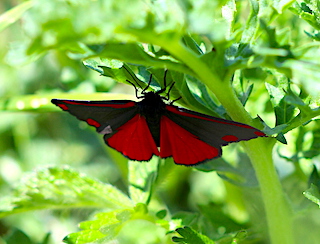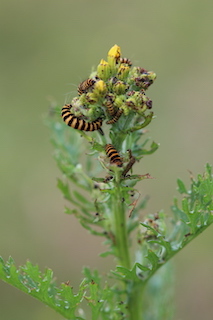 Cinnabar moths are on the wing from mid-May to early August, and their yellow and black banded caterpillars munch on Ragwort through the summer.
Cinnabar moths are on the wing from mid-May to early August, and their yellow and black banded caterpillars munch on Ragwort through the summer.
Photo: Amanda Scott
Scientific name: Tyria jacobaeae
Cornish name: Gouwan is the general word for moth
What to look for:
• Family: Arctiidae
• Colouring and appearance: Very distinctive, with red, black-bordered hindwings, and black forewings with red markings. Very occasional variations replace the red by yellow markings, or a red forewing with black border, or all-black wings.
• Size: Wingspan, 3.4 to 4.6 cm.
• Where: Mainly nocturnal, but will fly in sunshine, and easily disturbed. Widespread. Found in many open habitats, especially well-drained grassland, sand-dunes, heathland.
• When: Flight period is mid-May to early August.
• Caterpillar foodplant: Mostly Common Ragwort, but are also known to eat cultivated forms and Groundsel.
• Similar species: Burnet moths, such as the Six-spot Burnet Moth, which have narrower wings.
 In the moth world, it’s often the case that brightly coloured caterpillars transform into adults of more muted shades. Not so the Cinnabar. On the wing from the middle of May right through to early August, this moth is resplendent in its red and black colouring. Its caterpillars, with their yellow and black banding, are equally distinctive as they munch their way through Ragwort.
In the moth world, it’s often the case that brightly coloured caterpillars transform into adults of more muted shades. Not so the Cinnabar. On the wing from the middle of May right through to early August, this moth is resplendent in its red and black colouring. Its caterpillars, with their yellow and black banding, are equally distinctive as they munch their way through Ragwort.
While we may simply enjoy the attractive appearance of both adults and caterpillars, it tells a different story to potential predators. Pale yellow after first emerging, the caterpillars soon develop their bright yellow and black striping to warn creatures tempted to eat them that they taste extremely unpleasant – this is because they absorb poison from the leaves of their Ragwort foodplant. The adults retain this toxicity, and so their red and black colouring is also a warning.
Adult females lay batches of eggs (of around 40 to 50) on the underside of Ragwort leaves. After hatching and beginning to feed, the caterpillars may well strip the plant of all its leaves and flowers, leaving just a bare and very sorry-looking stem. They then overwinter just under the ground as pupae, before emerging in mid-May. As the adults have a long flight season (they are on the wing until early August), they can often be seen alongside their caterpillars.
 Did you know…?
Did you know…?
… Cinnabar is a bright red mineral, and this is the derivation of the moth’s common name.
More information and references:
Chinery, M., 2005. Collins Complete Guide to British Insects. Collins, London.
Waring, P., Townsend, M. and Lewington, R., 2009. Field Guide to the Moths of Great Britain and Ireland (second edition). British Wildlife Publishing, Gillingham, Dorset.
Published: May 2020
Author: Amanda Scott
Photos: Amanda Scott
